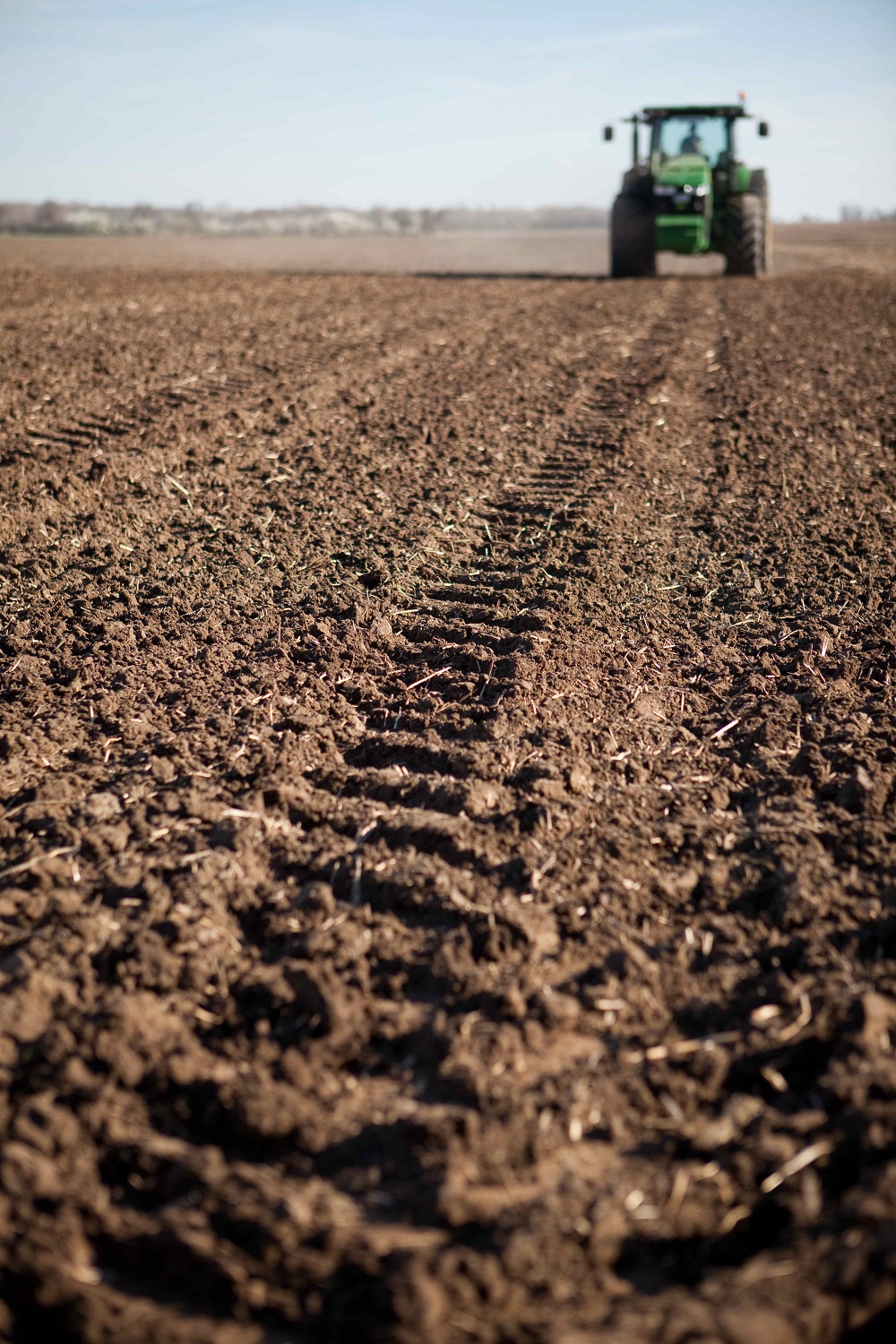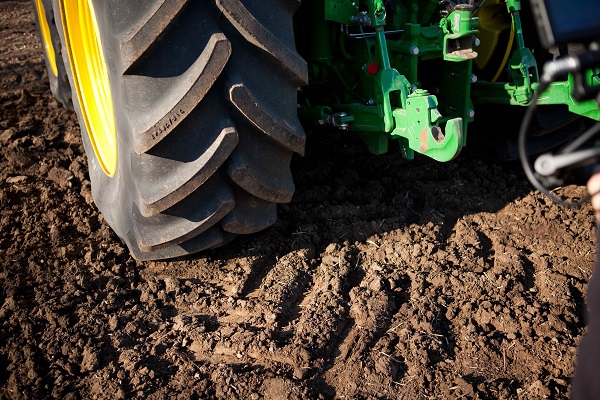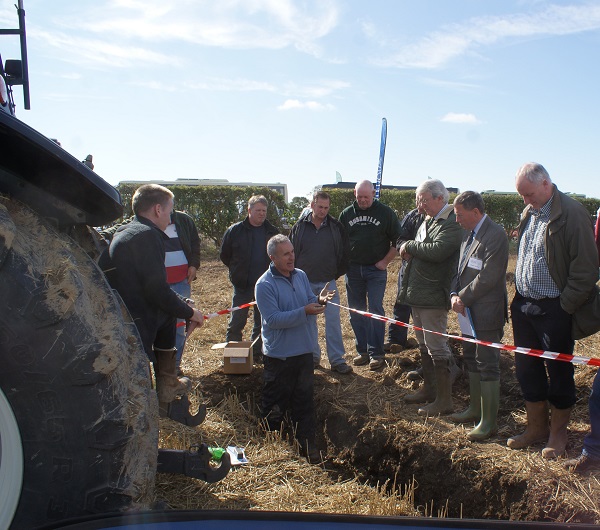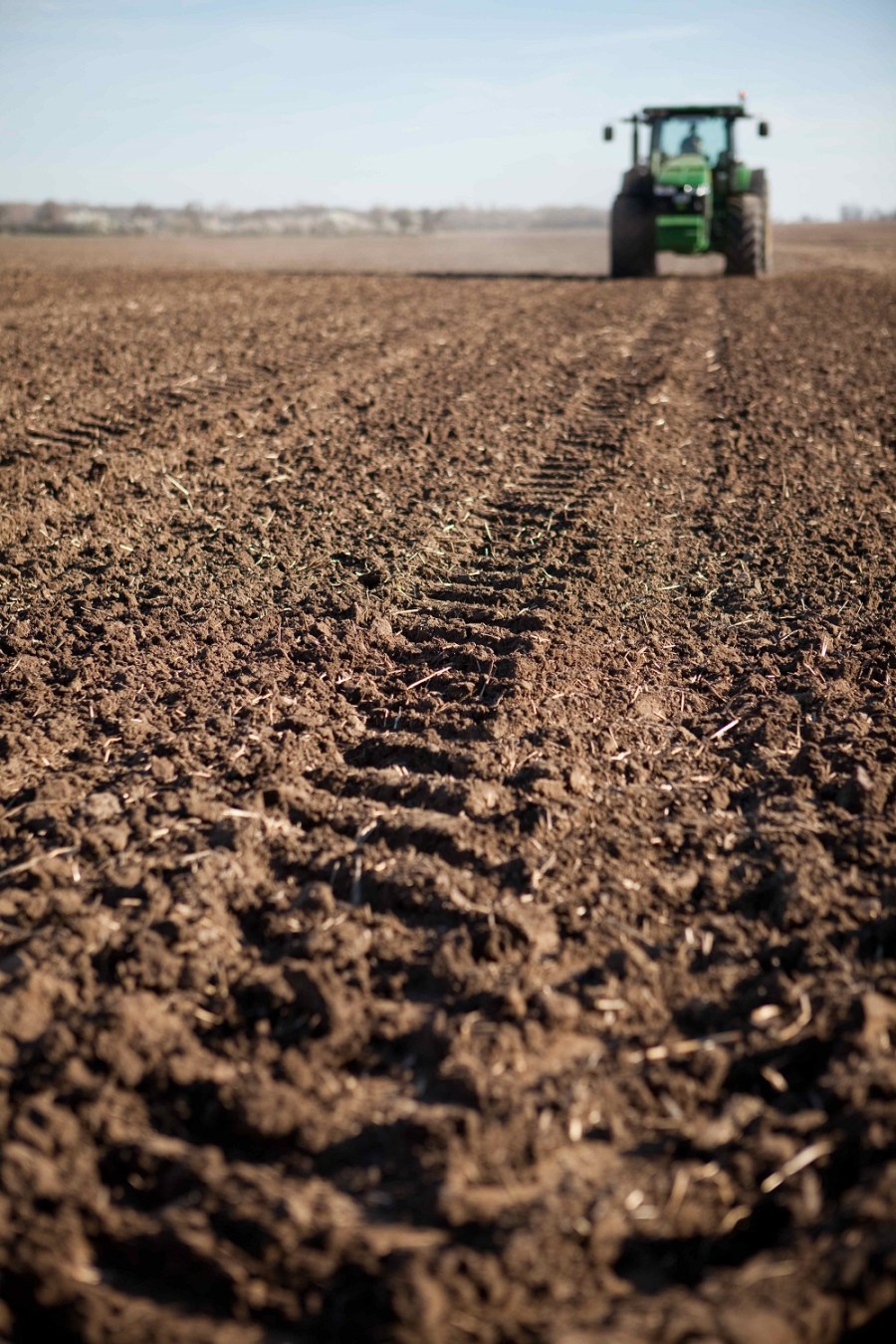Buying a bigger, hea vier tractor might up your work rate, but the chances are your soil won’t thank you for it. CPM weighs up the options for relieving some of that extra pressure.
vier tractor might up your work rate, but the chances are your soil won’t thank you for it. CPM weighs up the options for relieving some of that extra pressure.
By Ted Fleetwood
Every year the power of the average UK tractor creeps a little higher, and it’s easy to see why.
With that bit extra grunt you can pull some bigger kit, go that bit faster and with the time saved squeeze in a few extra acres – or clock off early for a swift one at the Dog and Badger, depending on your preferences.
But with extra power comes the inevitable penalty of weight. On the one hand this is handy for transferring all that extra muscle to the ground, but the flipside is that it slowly squeezes the life out of your soil.
Combining both VF tyres and central tyre inflation offers the maximum benefit.
Spread the ballast
Thankfully, there are some helpful tools available to help spread some of that extra ballast. Very high flexion (or VF) tyres have been around for little while now and can be run at much lower pressures than standard radials.
This means they have a considerably larger footprint – around 25% larger than standard – which transfers the load of the tractor over a larger area.

Bigger kit is handy for transferring all that extra muscle to the ground, but the flipside is that it slowly squeezes the life out of your soil.
On the road, these will still perform well at low pressures, meaning you don’t have to worry about keeping an air compressor at arm’s reach.
Those looking to go a step further can invest in a central tyre inflation system. These allow tyre pressures to be adjusted from the comfort of the tractor cab, meaning you can run them soft with a large footprint in the field and harder with a smaller footprint for efficiency on the road.
But what are the relative merits of each system and will the extra cash you spend on a central tyre inflation system be money well spent?
To find out, CPM quizzed soil expert Philip Wright of Wright Resolutions who’s carried out countless studies on the effects tyres and their pressures have on soil compaction.
What impact do tyre pressures have?
There are two main factors that cause soil damage when you drive over a field. One is the pressure inside the tyre,

Philip Wright encourages farmers to consider potential soil damage from both tyre pressure and axle load.
which determines how much damage is caused and the second is the axle load, which determines how deep the damage is pushed.
So, in an ideal world you want to run tyre pressures as low as possible and reduce the axle load, particularly when soils are wet or extensively loosened
Can VF tyres help?
The basic principle of tyre inflation is that more pressure is needed when either axle loads or forward speed goes up.
This extra pressure reduces the flexing of the tyre under load, meaning a greater pressure is transferred to the soil in a smaller localised area.
The VF technology tyres offer a significant advantage in the field as they’re designed to operate under high draft and load at considerably lower pressures than standard radial tyres.
They also have the added benefit of being able to operate at these same pressures for fast on-road applications. This avoids the usual need to raise pressures for high-speed, high-load applications, which helps when travelling between fields.
It’s also useful for contractors who have to switch regularly between jobs like haulage and cultivation work that would normally require you to alter tyre pressures.
Having said that, no tyre system can completely mitigate against axle load, which means extra weight can still cause problems further down the soil profile.
What about central tyre inflation?
Central inflation systems allow pressures to be changed relatively easily, so field pressures at slower speeds can be low and these then can be raised for faster transport between fields.
To an extent VF tyres mitigate against this, but if even lower pressures can be used in field, this system can allow for this. Drilling under damp conditions is one example where this can be beneficial.
If VF technology isn’t available, central tyre inflation allows (within the limits of tyre capability) a more standard tyre to be relatively easily adjusted between work and transport.
However, combining both VF tyres and central tyre inflation offers the maximum benefit.
Which system is better for soils?
When buying expensive machinery, like harvesters, the added cost of central inflation is relatively low, and well worth considering.
For slightly lower-cost purchases like tractors, trailers or sprayers, tyre specification should be a major consideration and VF tyres can significantly reduce soil damage without the additional cost of a central tyre inflation system.
However, as the technology gets cheaper and equipment gets heavier, central tyre inflation systems will be a more attractive investment.
What’s on the market?
Most tyre manufacturers now offer VF technology on their more premium ranges, but the specs, sizes and operating pressures do vary.
CPM talked to two leading tyre makers to see what’s on offer and how much VF tyres differ from their regular counterparts.
Until recently all of Bridgestone’s agricultural tyres sported the Firestone brand, but with the launch of its latest premium range, the Japanese maker decided to stamp its own name on the sidewalls.
The VT-Tractor range features very high flexion sidewalls that are capable of running at considerably lower pressures than a conventional tyre under the same load, says the firm.
This means they can carry either 40% more load or run at 40% lower pressure than a standard radial under its usual operating conditions.
Running at lower pressure also means the tyre sidewall bulges more, giving a claimed 26% larger lug contact area with the ground than a standard radial. This both reduces top-level soil damage and gives better grip, says Bridgestone’s Stephen Lamb.
“We’re finding that very high flexion tyres are getting more and more popular, particularly with contractors, as they only cost 10 to 15% more than a standard tyre, but you get a 40% improvement in performance.”
But as with all tyres it’s crucial to make sure they’re running at the correct pressure for the job in hand, he says. For example, a VF650/65 R42 tyre running at 0.6 bar will take a maximum load of around 3.4t per tyre up to a maximum speed of 50km/h.
However, if you want to up the load to 6t per tyre and still travel at 50km/h, you’ll need to run them at 1.6bar.
This is where central tyre inflation systems can help you get the most from a VF tyre, says Steve Lamb. “For example, if you’re towing a large slurry tanker on the road at 50km/h, you’ll probably be able to reduce your operating pressures even further as the load reduces from the tanker while working in the field.”
Czech tyre maker Mitas offers a premium VF tyre that’s rated to run at pressures as low as 0.4bar (if run as dual wheels) and 0.8bar as singles.
The HC2000 also has a 26% wider footprint than a standard tyre and is available in a number of rim sizes from 30-50in (75-125cm) and widths from 380-710mm.
As well as reducing soil damage the VF tyres give a smoother ride on the road and reduce wear, says Mitas’ Kirk Walker.
“Because the tyres are running at lower pressures on the road they act like suspension and reduce bouncing,” he says.
“They also tend to wear evenly – unlike over-inflated tyres that wear in the centre – as the whole width of the lug area is in contact with the road surface.”
Most other premium makers offer VF tyres, including Michelin and Trelleborg. They’ll also usually have a row-crop version as well as a model to suit the heaviest high-horsepower tractors.
For those looking for a halfway house between standard tyres and VF there’s the option of Improved Flexion Tyres (IF).
These typically have to run at 20% higher pressures than VF tyres for a given load and will be priced somewhere between standard and VF tyres.
Standard radials generally have to run a further 20% higher pressure than IF tyres for a given load. That adds up to a 40% difference between standard tyres and the top-end VFs.
Most tyre manufacturers now offer VF technology on their more premium ranges, but the specs, sizes and operating pressures do vary.
CPM talked to two leading tyre makers to see what’s on offer and how much VF tyres differ from their regular counterparts.
Until recently all of Bridgestone’s agricultural tyres sported the Firestone brand, but with the launch of its latest premium range, the Japanese maker decided to stamp its own name on the sidewalls.
The VT-Tractor range features very high flexion sidewalls that are capable of running at considerably lower pressures than a conventional tyre under the same load, says the firm.
This means they can carry either 40% more load or run at 40% lower pressure than a standard radial under its usual operating conditions.
Running at lower pressure also means the tyre sidewall bulges more, giving a claimed 26% larger lug contact area with the ground than a standard radial. This both reduces top-level soil damage and gives better grip, says Bridgestone’s Stephen Lamb.
“We’re finding that very high flexion tyres are getting more and more popular, particularly with contractors, as they only cost 10 to 15% more than a standard tyre, but you get a 40% improvement in performance.”
But as with all tyres it’s crucial to make sure they’re running at the correct pressure for the job in hand, he says. For example, a VF650/65 R42 tyre running at 0.6 bar will take a maximum load of around 3.4t per tyre up to a maximum speed of 50km/h.
However, if you want to up the load to 6t per tyre and still travel at 50km/h, you’ll need to run them at 1.6bar.
This is where central tyre inflation systems can help you get the most from a VF tyre, says Steve Lamb. “For example, if you’re towing a large slurry tanker on the road at 50km/h, you’ll probably be able to reduce your operating pressures even further as the load reduces from the tanker while working in the field.”
Czech tyre maker Mitas offers a premium VF tyre that’s rated to run at pressures as low as 0.4bar (if run as dual wheels) and 0.8bar as singles.
The HC2000 also has a 26% wider footprint than a standard tyre and is available in a number of rim sizes from 30-50in (75-125cm) and widths from 380-710mm.
As well as reducing soil damage the VF tyres give a smoother ride on the road and reduce wear, says Mitas’ Kirk Walker.
“Because the tyres are running at lower pressures on the road they act like suspension and reduce bouncing,” he says.
“They also tend to wear evenly – unlike over-inflated tyres that wear in the centre – as the whole width of the lug area is in contact with the road surface.”
Most other premium makers offer VF tyres, including Michelin and Trelleborg. They’ll also usually have a row-crop version as well as a model to suit the heaviest high-horsepower tractors.
For those looking for a halfway house between standard tyres and VF there’s the option of Improved Flexion Tyres (IF).
These typically have to run at 20% higher pressures than VF tyres for a given load and will be priced somewhere between standard and VF tyres.
Standard radials generally have to run a further 20% higher pressure than IF tyres for a given load. That adds up to a 40% difference between standard tyres and the top-end VFs.
Smooth ride for Oxon farm manager
Mark Oldroyd is farm manager for MES Dart and Partners and AG Hedges’ 1000ha arable and dairy enterprise near Wallingford, Oxon.

He’s been running a trial set of Bridgestone’s VT-Tractor very high flexion tyres for the past two years on a New
Holland T8.360 and has clocked up more than 1400 hours with them.
Many of these have been racked up using the farm’s 6m mounted Claydon drill, which they regularly have to take to the road to get between fields.
Mark Oldroyd has been running the VF710/ 70 R42 tyres at around 1.2bar, which means they’ll comfortably take the weight of the drill and he can travel at 50km/h on the road.
“One of the biggest things we’ve noticed is how much more comfortable they are than standard tyres,” he says.
“You don’t get any bouncing, they don’t seem to roll and there’s virtually no noise.”
He also reckons the larger footprint reduces soil damage and if you do end up making a mess the ground seems to recover quicker.
Off the back of his experiences, Mark Oldroyd has also invested in a similar set for the farm’s New Holland T7.200.
This is running VF650/ 65 R42s on the back, which are inflated to around 1bar. This tractor spends a lot of time towing muck spreaders and trailers, so is constantly switching between field and road work.
“The lower pressures mean the driver is more comfortable when moving between fields and when you get there you make less mess,” he says.
Although very high flexion tyres are expensive, Mark Oldroyd reckons they’re a good investment, particularly if bought with a new tractor.
“When we rolled them in with the deal it didn’t make a huge difference and if we can get 5000 hours out of them – which is when we usually look to replace our tractors – then I’ll be happy.”
The farm runs eight other New Holland tractors running on standard tyres and he says he’ll seriously consider switching to VF when they come to be traded in.
Mark Oldroyd says he’s interested in central tyre inflation systems as they allow you to get a bit more performance out of the tyres when switching between tasks with differing speeds and loads.
Central tyre inflation systems
Integrated central tyre inflation systems have been around for a while now on bigger kit like foragers and sugar beet harvesters.
But as yet, few tractor manufacturers offer a factory-fitted option. Fendt, however, does have a system called Variogrip that’s available on its bigger tractors.
This has an airline that runs neatly through the axle meaning there’s no need for external pipework and pressures can be adjusted on the in-cab Varioterminal from as low as 0.6bar up to 2.5bar.
The problem with this process is that it takes a good few minutes for the tyres to inflate. However, to help cut filling times, Mitas has come up with a system called Aircell that apparently gives a tenfold reduction in inflation times.
This is basically a tough air pocket mounted next to the rim, taking up about 30% of the volume of the tyre, that can be pumped up to pressures as high as 8bar, while the rest of the tyre remains at low pressure.
Then, when the tyre needs to be inflated, this vessel releases the high-pressure air into the rest of the tyre, boosting pressure by up to 1bar (from 0.8bar to 1.8 bar, for example) in less than 30 secs.
“Tyres can be run at low pressure in the field with air from the AirCell being released on demand for rapid pressure increase in the agricultural tyre itself ahead of roadwork. It can then be lost quickly again via a specially developed valve,” explains Jon Ward of Mitas.
“As the AirCell is constantly recharged, the inflation/deflation cycle can occur as often as the operator wishes.”
The AirCell will be available for the Fendt 900 Vario equipped with Mitas 710/75 R42 SFT starting in Nov 2016.
For those who are interested in central tyre inflation, but aren’t in the market for a new Fendt, North York firm Tractair has a solution.
It will retro-fit a central tyre inflation system to most models of tractor using a compressor and external air lines that run down the outside of the wheels.
At first glance these look like they’d easily be severed by wayward branches or tight gateways, but Tractair claims they’re tougher than they look. The lines are also fitted with quick-release valves so that the pipes can be quickly removed and stowed on the mudguards.
The firm’s midrange Airbox Drive system costs between £2300-3700 and can be operated via ISOBUS or on a dedicated control box in the cab.




